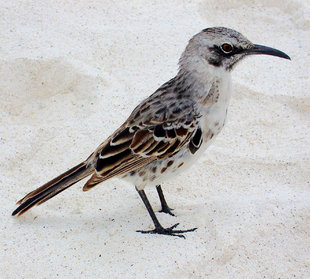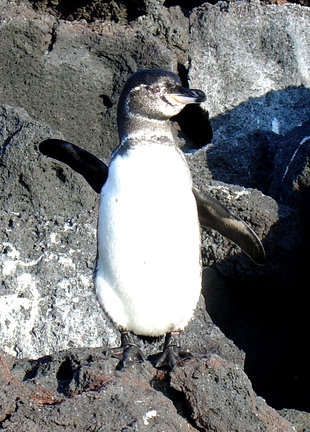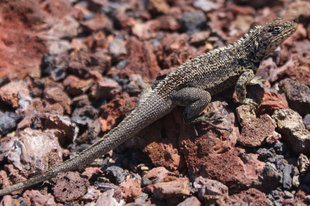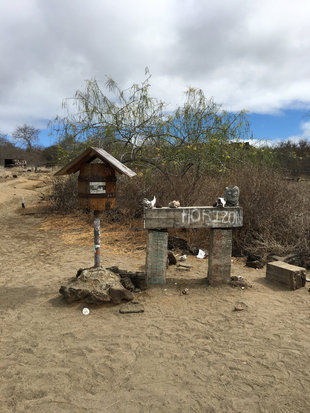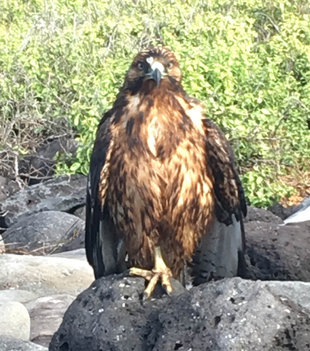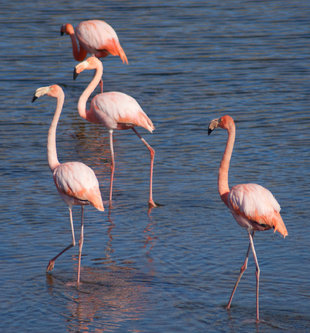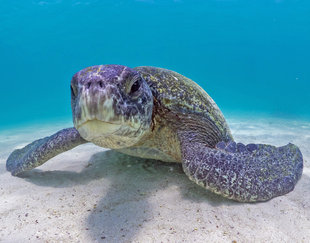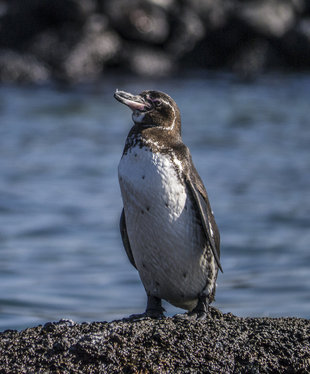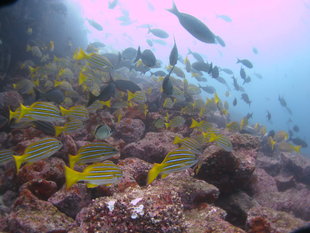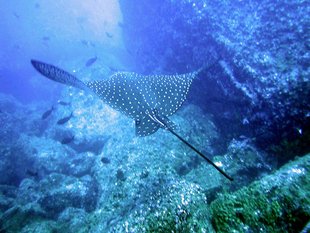Area Size: 173 Km²
Maximum Altitude: 640 meters / 2100 feet
Island Highlights: Project Floreana, Post Office Bay, Punta Cormorant, Devil's Crown, Flour Beach, Floreana Mockingbird, Galapagos Penguin, Giant Tortoise, Lava Lizard, Pink Flamingo, Green Sea Turtle, Coral Reef
Introduction
Floreana is one of the oldest Galapagos islands in the archipelago and consequently has a greater biodiversity than many of the younger islands.
Historically, Floreana has long been a favourite for passing travellers, including early visits from buccaneers, colonists and whalers. She was the first of the Galapagos islands to be inhabited by humans, with the first settlement established in 1830. However, later attempts to exploit the island's natural resources resulted in failure, meaning that there were no humans on the island between the 1870s and 1930s. Today, Floreana has only one small village, Puerto Velasco Ibarra.
From now until 2014, the WWF, Charles Darwin Foundation, Galapagos National Park and one of Aqua-Firma's Ecuadorian representatives will be running Project Floreana. The project endeavours to inspire bold island conservation efforts and embrace the local community a solution to the islands problems rather than the cause. Aqua-Firma wholeheartedly supports projects such as this and understands how valuable Project Floreana is in preserving the wildlife, habitats and community which contribute to making Floreana such a wonderful island to visit.
Post Office Bay was named as such, after British whalers created a Post Office Barrel as a means of sending letters to and from England. The tradition still remains to this day, with visitors given the chance to pick up and drop off letters and postcards without stamps to be transported to far away destinations.
You can visit Floreana with Aqua-Firma by means of a Wildlife Yacht Safari, the yacht based section of a Galapagos Yacht & Lodge Safari or for a day's diving as part of a Hotel Based Boat Diving Holiday.
Wildlife
The Floreana lava lizard is the smallest of all of the seven endemic Galapagos lava lizards. It resides exclusively on Floreana island and its nearby islets.
The largest populations of flamingos in the Galapagos archipelago can be found at Punta Cormorant, spending approximately seven hours of their day eating. The area where the flamingos reside, presents excellent photographic opportunities, where these pink residents can be watched wading gracefully through the brackish lagoon in an almost ballerina fashion.
The only place where the endemic Floreana mocking bird can be found is on the small islet of Champion. Although visitors are prohibited to go ashore here, the mockingbird is likely to be seen hopping between the dry vegetation and rocks along the shoreline. In addition, large numbers of sea lions can are also seen here.
Other fascinating birdlife that one can expect to see at Punta Cormorant include the distinctive oystercatcher, willets, whimbrels, black-necked stilt and white-cheeked pintail ducks, while Galapagos hawks survey the lagoon from overhead.
Marine Life
A truly spectacular dive site on the island is that of Devil's Crown, born out of the eroded remains of a volcanic cone. There are also fantastic opportunities here for snorkelling, an activity which is very often accompanied by playful sea lions. The Devil's Crown is home to an abundance of brightly coloured and fascinating marine life including jacks, Pacific green turtles, hammerheads and reef sharks. Nestled away in the more sheltered areas between the boulders, one may also catch sight of stingrays and other smaller fish such as hawk fish, filefish, king angelfishes, Creole fish and grunts.
Between September and May, Punta Cormorant provides fantastic opportunities to see sea turtles nesting on the white sandy beach, which is just a short walk away from the 'green' beach and popular wet landing site.
A particularly noteworthy area of Floreana to visit is La Luz del Dia (the light of day), a small cove rich in an abundance of marine life, including Galapagos penguins, sea lions, rays and other tropical fish.
Conservation Issues
Following the removal of Floreana's introduced mammalian invaders, many of the islands threatened endemic plant species are now flourishing. Unfortunately, this has brought with it the flourishing of some particularly unsavoury weeds. However, with the employment of local residents, substantial ongoing efforts have been made to control the spread of these weeds.
The involvement of local residents is of utmost importance throughout the development of Project Floreana. As guardians of the island, it is crucial that the locals are fully engaged with planning and decision making. The project aims to educate locals by encouraging sustainable living, focusing on waste management, water, energy and agricultural production. Investments will be made to help fund vocational training and education for local residents, in the hope that Floreana will provide an example to the rest of the archipelago and ultimately the world.
The reintroduction of several extinct endemic species is at the forefront of Project Floreana, with the removal of foreign invaders that contributed to their extinction in the first place. The Floreana mocking bird is the flagship of the Project, as it represents the fundamental link between Darwin and his theory of natural selection. It is estimated that there are now approximately 470 Floreana mocking birds in existence, dispersed between two small offshore islets. Although the population appears relatively stable, the limited distribution of the mockingbird makes this species highly vulnerable. Like the mockingbird, the Galapagos Racer Snake (Philodryas biserialis) can also only be found residing on these islets. Before the Floreana mockingbird and the racer snake can be reintroduced to the main island, careful planning and action needs to be adhered to, in particular the control and/or removal or invasive species, habitat restoration and reducing the threat of disease.
The presence of rats, mice and cats has been a significant problem on the island, in particular for the bird population of whose eggs are a prime target. Extensive work has been carried out to control these mammals, particularly around the petrel breeding areas, with the ultimate aim being a complete eradication.
The Floreana tortoise is believed to have become extinct in around 1850. However, scientists have since identified nine tortoises with apparent Floreana ancestry. The tortoises (6 females and 3 males) are currently housed at the Charles Darwin Research Station and are hoped to become part of a proposed breeding programme.
Puerto Velasco Ibarra was once a highly productive, thriving marine port, with an abundance of lobsters, groupers and other fish. In recent years, the area has become heavily overfished, resulting in dwindling fish populations. However, a recent proposal to protect a 4 km stretch of coastline, whilst allowing fishing to continue on the adjacent stretch, hopes to encourage a restoration process among such declining populations.
Floreana coral was once a thriving and bountiful species of the Galapagos Islands, however; the El Niño event of 1983 resulted in much of this beautiful species to be wiped out. Due to the unique biodiversity that exists in the Galapagos waters, such coral is valued and as a consequence, the region is protected by being designated a Marine Reserve and World Heritage Site. Floreana coral is included in the appendix of the Convention on International Trade in Endangered Species, meaning that the trade of it is carefully regulated; however, it is still at risk from natural disasters and climate change.
Geology
Geologically, the island is composed of a series of eroded volcanic hills. It is impossible to identify a central volcano due to the age and formation of the hills, however there are no existing signs of recent volcanic activity.
Interestingly, there are two highly contrasting beaches that exist on Floreana. Situated at Punta Cormorant, the landing beach consists of glistening green volcanic olivine crystals, while the other, known as Flour Beach comprises very fine white sand derived from the erosion of coral skeletons and is a nesting site for green turtles. Between the two beaches lies a hyper saline lagoon, which is most often frequented by flamingos, pintails, stilts and other wading birds.
Floreana

